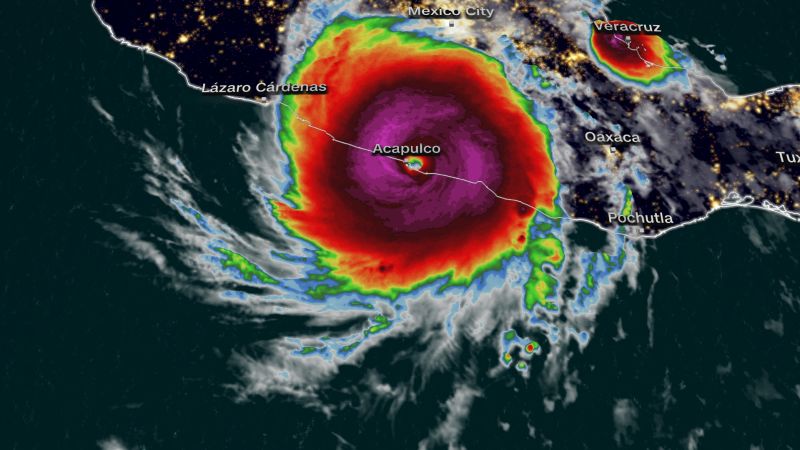CNN
—
Hurricane Otis knocked out all communications and unleashed a “nightmare scenario” in Acapulco in southern Mexico in Wednesday morning after the storm rapidly intensified into a Category 5 just before landfall and gave officials and residents little time to prepare.
Otis strengthened from a tropical storm to an extremely dangerous Category 5 hurricane in just 12 hours before it slammed ashore near Acapulco as the strongest storm on record to hit this area and the Pacific coast of Mexico.
The sudden burst of power gave people little time to prepare or get to safety as Otis bore down on Acapulco, the popular tourist destination that’s also a permanent home to roughly 800,000 people.
As Otis kept strengthening and neared the coast, forecasters at the National Hurricane Center warned that a “nightmare scenario is unfolding.”
Otis’ center slammed into Mexico’s coast near Acapulco at around 12:25 a.m. local time with sustained winds of 165 mph, the National Hurricane Center said. The storm is now headed inland with winds of 80 mph and is expected to dissipate over southern Mexico by Wednesday night, the center said.
The impact of the storm is not yet clear. Mexico’s President Andrés Manuel Lopez Obrador said Wednesday morning his government has no reports of casualties but all communication systems in the area are down, including with emergency crews on the ground.
“We don’t have a damage assessment because until now, there is no communication with Acapulco,” National Coordinator of Civil Protection Laura Velázquez said in an interview with local news Milenio TV. Velázquez reiterated there is no information either on injured or missing people as all communication systems are currently down, including the ones used by the Navy.
President Obrador said they do have reports of material damage and blocked roads.
“The highway to Acapulco is blocked by landslides,” he said. “Today we will continue with the rescue efforts for the ones affected.”
He said there were currently no options for flying to Acapulco to see the impact, saying they needed to wait for the storm to pass.
Emergency crews were attempting to access the area by road to try to assess the damage, Velázquez said.
“We do not know what time we are going to arrive, but we are going to arrive with all the help,” she added.
The storm knocked out power to over 500,000 customers in Mexico’s Guerrero state, the power company CFE said in a statement. Power was restored to 40% of those customers, the utility added.
On Tuesday night, the president implored coastal residents of the state of Guerrero, which includes Acapulco, to seek shelter and stay away from rivers, streams and ravines ahead of the storm’s landfall.
Guerrero Gov. Evelyn Salgado Pineda announced Wednesday morning temporary shelters were open in Tecpan de Galeana, Coyuca de Benítez and Acapulco.
Otis’ intensification was among the fastest forecasters have seen; its top-end windspeed increased by 115 mph in 24 hours and 90 mph in a 12-hour period.
The storm’s rapid intensification is a symptom of the human-caused climate crisis, scientists say – and one that is becoming more frequent.
Scientists have defined rapid intensification as a wind speed increase of at least 35 mph in 24 hours or less, generally requiring significant ocean heat.
More than 90% of warming around the globe over the past 50 years has taken place in the oceans, according to the National Oceanic and Atmospheric Administration. In addition, El Niño is growing in the Pacific this year, driving ocean temperatures even higher.
Otis’ strengthening “was extremely unusual,” Brian McNoldy, an atmospheric scientist at the University of Miami, told CNN. “It’s unfortunate it happened right before making landfall, but if this had occurred over the open ocean, it still would have been very remarkable.”
Before Otis, there had not been a Category 5 landfall for the East Pacific, according to the NOAA Hurricane Database. The previous strongest landfall was Hurricane Patricia in 2015, which made landfall as a Category 4 Hurricane with winds of 150 mph.
Unlike Otis, which has made landfall close to a major urban area, Patricia plowed through a sparsely populated and mountainous stretch of the coast, sparing Puerto Vallarta and Manzanillo.

Sarah Wilson is your guide to the latest trends, viral sensations, and internet phenomena. With a finger on the pulse of digital culture, she explores what’s trending across social media and pop culture, keeping readers in the know about the latest online sensations.








